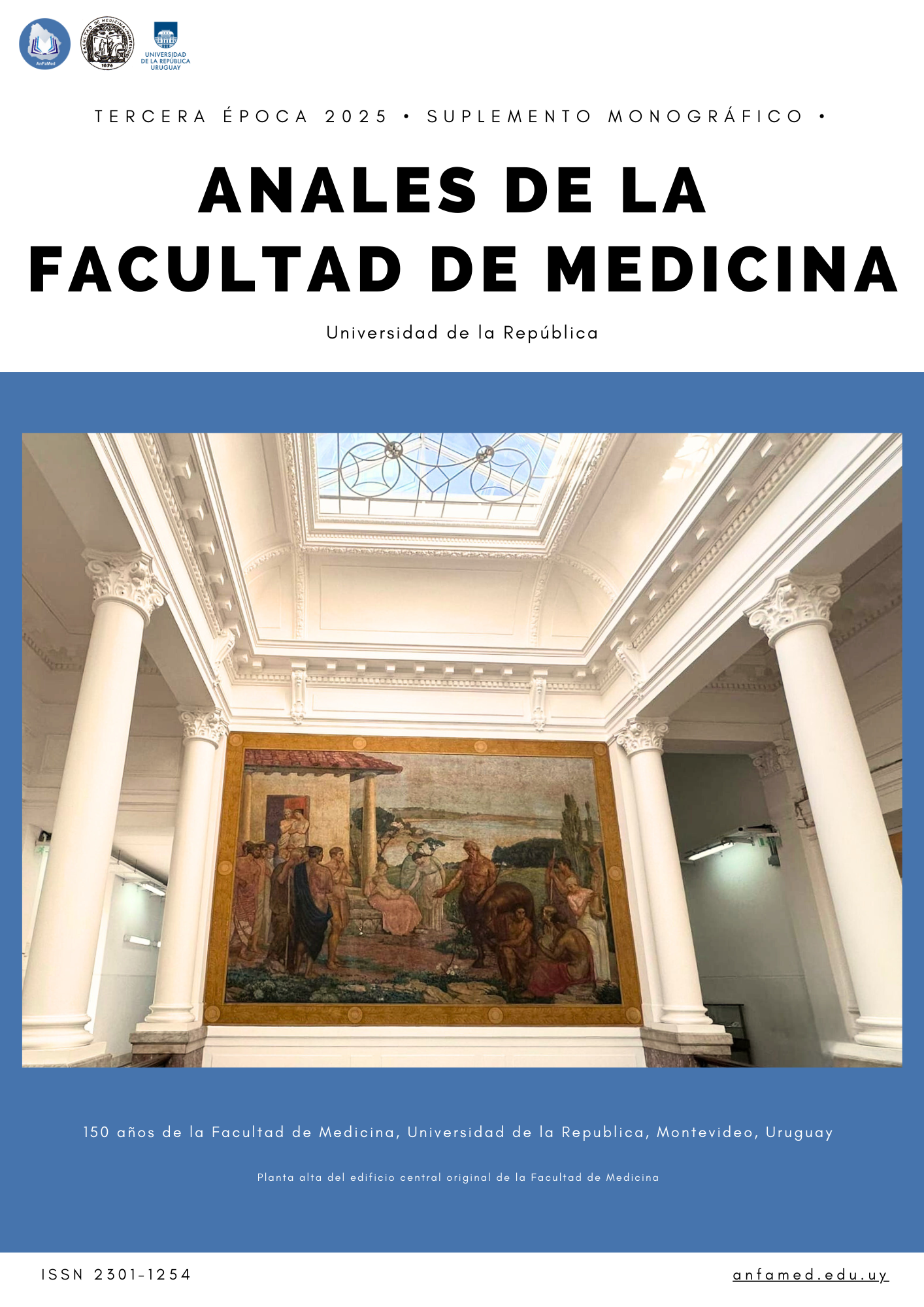Gastroesophageal motility disorders in Chagas disease, Hospital de Clínicas, Montevideo, Uruguay, 2024
Abstract
A descriptive and cross-sectional study was carried out, with the target population being patients over 18 years of age with Trypanosoma cruzi (T. cruzi) infection, assisted in the period from July 1 to September 1, 2024, at the Chagas Disease Clinic of the Hospital de Clínicas, Montevideo, Uruguay. Patients with swallowing disorders and pregnant women were excluded.
The method used to assess gastroesophageal involvement is esophageal transit through the use of radiotracers. It is a diagnostic study that uses a solution with a radioactive substance (metastable technetium 99) and liquid, which is ingested to evaluate its passage through the digestive tract. This was recorded in a sequence of images by a gamma camera, whose data were digitized in time-activity curves, characterizing the alterations in esophageal transit and gastric emptying.
20% had at least one digestive symptom. Of this percentage, all presented slow esophageal transit and 10% presented slow gastric emptying.
Of the eight asymptomatic patients (80%), 50% presented slow esophageal transit in the middle and distal third, 12.5% slow transit in the distal third, 12.5% slow transit throughout the esophageal transit, and 25% had a tortuous esophagus. Scintigraphy is a very sensitive but not very specific diagnostic method; it was concluded that it is relevant to include it in a study algorithm in this population. This allows measures to be taken to reduce the progression to a more severe symptomatic stage.
Downloads
References
Chagas disease (also known as American trypanosomiasis) [Internet]. World Health Organization; 2025 [cited 2025 May 29]. Available from: https://www.who.int/news-room/fact-sheets/detail/chagas-disease-(americantrypanosomiasis)
Moya P, Basso B, Moretti E. Enfermedad de Chagas Congénita en Córdoba, Argentina: Aspectos epidemiológicos, clínicos, diagnósticos y terapéuticos. Experiencia de 30 años de seguimiento [Internet]. 2005 [cited 2024 Nov 16]. Available from: https://pesquisa.bvsalud.org/portal/resource/pt/lil444180?lang=en
Conti Díaz IA. A propósito del centenario del descubrimiento de laenfermedad de Chagas. Análisis Cronológico de los principales hitos en la Evolución de su conocimiento y control con particular énfasis en las contribuciones Científicas Uruguayas [Internet]. Sindicato Médico del Uruguay; 2010 [cited 2024 Nov 18]. Available from: http://www.scielo.edu.uy/scielo.php?script=sci_arttext&pid=S1688-03902010000200008
Uruguay es el 1o país de América latina libre del insecto que transmite el mal de Chagas [Internet]. 2012 [cited 2024 Nov 18]. Available from: https://www.paho.org/es/noticias/25-5-2012-uruguay-es-1o-pais-america-latinalibre-insecto-que-transmite-mal-chagas
CDC - DPDx - american trypanosomiasis [Internet]. Centers for Disease Control and Prevention; 2021 [cited 2024 Nov 17]. Available from: https://www.cdc.gov/dpdx/trypanosomiasisamerican/index.html
Faral-Tello P, Greif G, Romero S, Cabrera A, Oviedo C, González T, et al. Trypanosoma cruzi isolates naturally adapted to congenital transmission display a unique strategy of Transplacental Passage [Internet]. U.S. National Library of Medicine; 2023 [cited 2024 Nov 16]. Available from: https://pubmed.ncbi.nlm.nih.gov/36786574/
Alcides Bocchi EA, Kalil R, Bacal F, de Lourdes Higuchi M, Meneghetti C, Magalhães A, et al. Magnetic Resonance Imaging in chronic chagas’ disease. Echocardiography. 1998 Apr;15(3):279–87. doi:10.1111/j.1540-8175.1998.tb00608.x
Gómez Pereira A, Calegari AM. Miocardiopatía chagásica crónica. Revista médica del Uruguay. 1986;2: 186-192.
Silvestrini MM, Alessio GD, Frias BE, Sales Júnior PA, Araújo MS, Silvestrini CM. New insights into Trypanosoma cruzi genetic diversity, and its influence on parasite biology and clinical outcomes. Frontiers in Immunology. 2024 Apr 9;15:1342431. doi:10.3389/fimmu.2024.1342431
Messenger LA, Miles MA, Bern C. Between a bug and a hard place:trypanosoma cruzigenetic diversity and the clinical outcomes of Chagas disease. Expert Review of Anti-infective Therapy. 2015 Jul 10;13(8):995–1029. doi: 10.1586/14787210.2015.1056158
Torres-Aguilera M, Remes-Troche J, Roesch-Dietlen F, Vázquez-Jiménez J, De la Cruz-Patiño E, Grube-Pagola P, et al. Alteraciones Motoras del Esófago en sujetos asintomáticos con infección crónica por trypanosoma cruzi. Revista
de Gastroenterología de México. 2011 July;76(3):199-208.
Remes-Troche JM, Torres-Aguilera M, Antonio-Cruz KA, VazquezJimenez G, De-La-Cruz-Patiño E. Esophageal motor disorders in subjects with incidentally discovered Chagas disease: A study using high-resolution manometry and the Chicago classification. Diseases of the Esophagus. 2012 Oct 22;27(6):524–9. doi:10.1111/j.1442-2050.2012.01438.x
Mut F. Exploración funcional del esófago con isótopos radiactivos [Internet]. 1998 [cited 2024 Nov 16]. Available from: https://www.subimn.org.uy/materiales/monografias-articulos/monografia-3/
Ponce de León, R y col. Enfermedad de Chagas. Estudio en pacientes asintomáticos. Revista Médica del Uruguay. 1986; 2: 132-l42.
Núñez M. Protocolos Técnicos en Medicina Nuclear [Internet]. 2000 [cited 2024 Nov 17]. Available from: http://www.subimn.org.uy/materiales/protocolos/protocolo-1/
Rezende Filho J, Oliveira RB. Estudo cintilográfico do trânsito esofagiano na esofagopatia chagásica crônica. 1985. (Tese). Faculdade de Medicina de Ribeirão Preto, Universidade de São Paulo, 1985.
Dumont SM, Costa HS, Chaves AT, Nunes M do CP, Marino VP, Rocha MO. Radionuclide esophageal transit scintigraphy in chronic indeterminate and cardiac forms of Chagas disease. Nuclear Medicine Communications. 2020 Jun;41(6):510–6. doi:10.1097/mnm.0000000000001186
Uriarte Vergara B, del Hoyo Artxabala I, González de Miguel M, Gutiérrez Ferreras A, Azpiazu Arnaiz P, Vilar Archabal Í, et al. Megacolon chagásico. Revista de cirugía española. 2016;94(Espec Congr):729.
Copyright (c) 2025 Guillermina Caraballo, Martina Acosta, Oriana Gáspari, Florencia Grossi, Matías Link, Camila Sena, César Ferreira, Selva Romero

This work is licensed under a Creative Commons Attribution 4.0 International License.
The authors retain their copyright and assign to the journal the right of first publication of their work, which will be simultaneously subject to the Creative Commons Attribution 4.0 International License. that allows sharing the work as long as the initial publication in this magazine is indicated.














